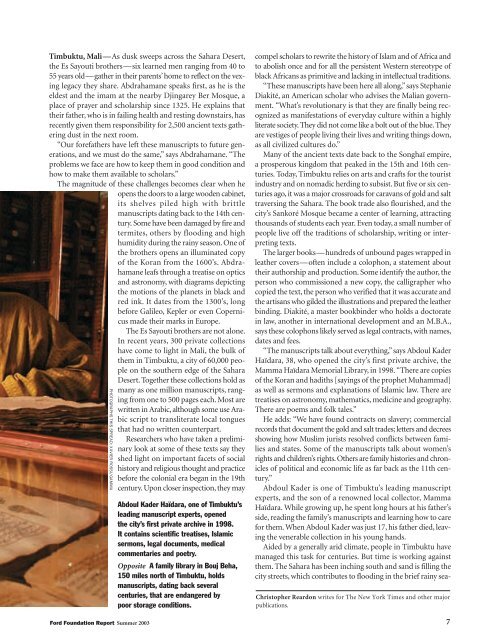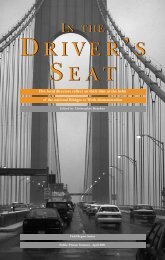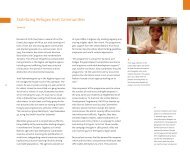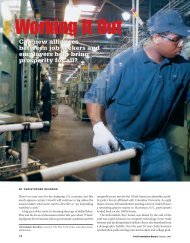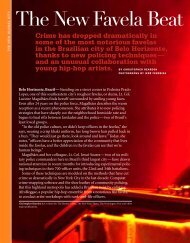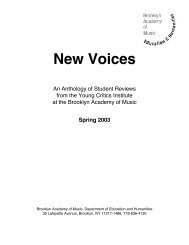Secrets of the Sahara - christopher reardon
Secrets of the Sahara - christopher reardon
Secrets of the Sahara - christopher reardon
Create successful ePaper yourself
Turn your PDF publications into a flip-book with our unique Google optimized e-Paper software.
Timbuktu, Mali—As dusk sweeps across <strong>the</strong> <strong>Sahara</strong> Desert,<br />
<strong>the</strong> Es Sayouti bro<strong>the</strong>rs—six learned men ranging from 40 to<br />
55 years old—ga<strong>the</strong>r in <strong>the</strong>ir parents’home to reflect on <strong>the</strong> vexing<br />
legacy <strong>the</strong>y share. Abdrahamane speaks first, as he is <strong>the</strong><br />
eldest and <strong>the</strong> imam at <strong>the</strong> nearby Djingarey Ber Mosque, a<br />
place <strong>of</strong> prayer and scholarship since 1325. He explains that<br />
<strong>the</strong>ir fa<strong>the</strong>r, who is in failing health and resting downstairs, has<br />
recently given <strong>the</strong>m responsibility for 2,500 ancient texts ga<strong>the</strong>ring<br />
dust in <strong>the</strong> next room.<br />
“Our forefa<strong>the</strong>rs have left <strong>the</strong>se manuscripts to future generations,<br />
and we must do <strong>the</strong> same,” says Abdrahamane. “The<br />
problems we face are how to keep <strong>the</strong>m in good condition and<br />
how to make <strong>the</strong>m available to scholars.”<br />
The magnitude <strong>of</strong> <strong>the</strong>se challenges becomes clear when he<br />
opens <strong>the</strong> doors to a large wooden cabinet,<br />
its shelves piled high with brittle<br />
manuscripts dating back to <strong>the</strong> 14th century.<br />
Some have been damaged by fire and<br />
termites, o<strong>the</strong>rs by flooding and high<br />
humidity during <strong>the</strong> rainy season. One <strong>of</strong><br />
<strong>the</strong> bro<strong>the</strong>rs opens an illuminated copy<br />
<strong>of</strong> <strong>the</strong> Koran from <strong>the</strong> 1600’s. Abdrahamane<br />
leafs through a treatise on optics<br />
and astronomy, with diagrams depicting<br />
<strong>the</strong> motions <strong>of</strong> <strong>the</strong> planets in black and<br />
red ink. It dates from <strong>the</strong> 1300’s, long<br />
before Galileo, Kepler or even Copernicus<br />
made <strong>the</strong>ir marks in Europe.<br />
The Es Sayouti bro<strong>the</strong>rs are not alone.<br />
In recent years, 300 private collections<br />
have come to light in Mali, <strong>the</strong> bulk <strong>of</strong><br />
<strong>the</strong>m in Timbuktu, a city <strong>of</strong> 60,000 people<br />
on <strong>the</strong> sou<strong>the</strong>rn edge <strong>of</strong> <strong>the</strong> <strong>Sahara</strong><br />
Desert. Toge<strong>the</strong>r <strong>the</strong>se collections hold as<br />
many as one million manuscripts, ranging<br />
from one to 500 pages each. Most are<br />
written in Arabic, although some use Arabic<br />
script to transliterate local tongues<br />
that had no written counterpart.<br />
Researchers who have taken a preliminary<br />
look at some <strong>of</strong> <strong>the</strong>se texts say <strong>the</strong>y<br />
shed light on important facets <strong>of</strong> social<br />
history and religious thought and practice<br />
before <strong>the</strong> colonial era began in <strong>the</strong> 19th<br />
century. Upon closer inspection, <strong>the</strong>y may<br />
PHOTOGRAPHS THIS SPREAD: XAVIER ROSSI/GAMMA<br />
Abdoul Kader Haïdara, one <strong>of</strong> Timbuktu’s<br />
leading manuscript experts, opened<br />
<strong>the</strong> city’s first private archive in 1998.<br />
It contains scientific treatises, Islamic<br />
sermons, legal documents, medical<br />
commentaries and poetry.<br />
Opposite A family library in Bouj Beha,<br />
150 miles north <strong>of</strong> Timbuktu, holds<br />
manuscripts, dating back several<br />
centuries, that are endangered by<br />
poor storage conditions.<br />
compel scholars to rewrite <strong>the</strong> history <strong>of</strong> Islam and <strong>of</strong> Africa and<br />
to abolish once and for all <strong>the</strong> persistent Western stereotype <strong>of</strong><br />
black Africans as primitive and lacking in intellectual traditions.<br />
“These manuscripts have been here all along,”says Stephanie<br />
Diakité, an American scholar who advises <strong>the</strong> Malian government.<br />
“What’s revolutionary is that <strong>the</strong>y are finally being recognized<br />
as manifestations <strong>of</strong> everyday culture within a highly<br />
literate society. They did not come like a bolt out <strong>of</strong> <strong>the</strong> blue. They<br />
are vestiges <strong>of</strong> people living <strong>the</strong>ir lives and writing things down,<br />
as all civilized cultures do.”<br />
Many <strong>of</strong> <strong>the</strong> ancient texts date back to <strong>the</strong> Songhaï empire,<br />
a prosperous kingdom that peaked in <strong>the</strong> 15th and 16th centuries.<br />
Today, Timbuktu relies on arts and crafts for <strong>the</strong> tourist<br />
industry and on nomadic herding to subsist. But five or six centuries<br />
ago, it was a major crossroads for caravans <strong>of</strong> gold and salt<br />
traversing <strong>the</strong> <strong>Sahara</strong>. The book trade also flourished, and <strong>the</strong><br />
city’s Sankoré Mosque became a center <strong>of</strong> learning, attracting<br />
thousands <strong>of</strong> students each year. Even today, a small number <strong>of</strong><br />
people live <strong>of</strong>f <strong>the</strong> traditions <strong>of</strong> scholarship, writing or interpreting<br />
texts.<br />
The larger books—hundreds <strong>of</strong> unbound pages wrapped in<br />
lea<strong>the</strong>r covers—<strong>of</strong>ten include a colophon, a statement about<br />
<strong>the</strong>ir authorship and production. Some identify <strong>the</strong> author, <strong>the</strong><br />
person who commissioned a new copy, <strong>the</strong> calligrapher who<br />
copied <strong>the</strong> text, <strong>the</strong> person who verified that it was accurate and<br />
<strong>the</strong> artisans who gilded <strong>the</strong> illustrations and prepared <strong>the</strong> lea<strong>the</strong>r<br />
binding. Diakité, a master bookbinder who holds a doctorate<br />
in law, ano<strong>the</strong>r in international development and an M.B.A.,<br />
says <strong>the</strong>se colophons likely served as legal contracts, with names,<br />
dates and fees.<br />
“The manuscripts talk about everything,”says Abdoul Kader<br />
Haïdara, 38, who opened <strong>the</strong> city’s first private archive, <strong>the</strong><br />
Mamma Haïdara Memorial Library, in 1998. “There are copies<br />
<strong>of</strong> <strong>the</strong> Koran and hadiths [sayings <strong>of</strong> <strong>the</strong> prophet Muhammad]<br />
as well as sermons and explanations <strong>of</strong> Islamic law. There are<br />
treatises on astronomy, ma<strong>the</strong>matics, medicine and geography.<br />
There are poems and folk tales.”<br />
He adds: “We have found contracts on slavery; commercial<br />
records that document <strong>the</strong> gold and salt trades; letters and decrees<br />
showing how Muslim jurists resolved conflicts between families<br />
and states. Some <strong>of</strong> <strong>the</strong> manuscripts talk about women’s<br />
rights and children’s rights. O<strong>the</strong>rs are family histories and chronicles<br />
<strong>of</strong> political and economic life as far back as <strong>the</strong> 11th century.”<br />
Abdoul Kader is one <strong>of</strong> Timbuktu’s leading manuscript<br />
experts, and <strong>the</strong> son <strong>of</strong> a renowned local collector, Mamma<br />
Haïdara. While growing up, he spent long hours at his fa<strong>the</strong>r’s<br />
side, reading <strong>the</strong> family’s manuscripts and learning how to care<br />
for <strong>the</strong>m. When Abdoul Kader was just 17, his fa<strong>the</strong>r died, leaving<br />
<strong>the</strong> venerable collection in his young hands.<br />
Aided by a generally arid climate, people in Timbuktu have<br />
managed this task for centuries. But time is working against<br />
<strong>the</strong>m. The <strong>Sahara</strong> has been inching south and sand is filling <strong>the</strong><br />
city streets, which contributes to flooding in <strong>the</strong> brief rainy sea-<br />
Christopher Reardon writes for The New York Times and o<strong>the</strong>r major<br />
publications.<br />
Ford Foundation Report Summer 2003 7


